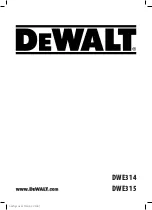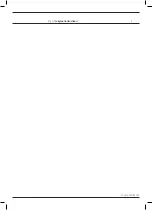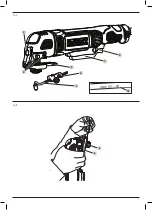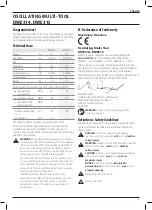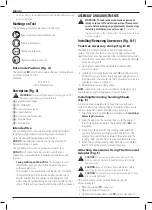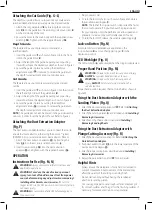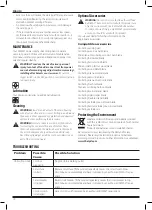
8
English
• Take the time to thoroughly read and understand this manual
prior to operation.
Markings on Tool
The following pictograms are shown on the tool:
Read instruction manual before use.
Wear ear protection.
Wear eye protection.
Wear respiratory protection.
Date Code Position (Fig. A)
The date code
20
, which also includes
the year of manufacture,
is printed into the housing.
Example:
2019 XX XX
Year of Manufacture
Description (Fig. A)
WARNING:
Never modify the power tool or any part of it.
Damage or personal injury could result.
1
Variable speed trigger
2
LED Worklight
3
Accessory clamp lever
4
Lock-on button
5
Accessory side mount slots
6
Cut guide block
7
Cut guide arm
Intended Use
This oscillating multi-tool is designed for professional detail
sanding, plunge cutting, flush cutting, removal of excess
materials and surface preparation applications.
DO nOT
use under wet conditions or in the presence of
flammable liquids or gases.
This oscillating multi-tool is a professional power tool.
DO nOT
let children come into contact with the tool.
Supervision is required when inexperienced operators use
this tool.
•
Young children and the infirm.
This appliance is not
intended for use by young children or infirm persons
without supervision.
• This product is not intended for use by persons (including
children) suffering from diminished physical, sensory or
mental abilities; lack of experience, knowledge or skills
unless they are supervised by a person responsible for their
safety. Children should never be left alone with this product.
ASSEMBLY AND ADJUSTMENTS
WARNING: To reduce the risk of serious personal
injury, turn tool off and disconnect tool from power
source before making any adjustments or removing/
installing attachments or accessories.
Be sure the
trigger switch is in the OFF position. An accidental start-up
can cause injury.
Installing/Removing Accessories (Fig. B–F)
Tool-free Accessory clamp (Fig. B–D)
The DWE314, DWE315 features a quick change accessory
system. This allows for faster accessory changes without the
need for wrenches or hex keys like other oscillating tool systems.
1. Grasp the tool and squeeze the accessory clamping lever
3
as shown in figure B.
2. Clean any residual debris from the tool shaft and the
accessory holder.
3. Slide the accessory between the shaft
8
and the accessory
holder making sure the accessory engages all eight pins on
the holder and is flush with the shaft. Ensure the accessory is
oriented as shown in Figure C.
4. Release the accessory clamp lever.
nOTE:
Some accessories, such as scrapers and blades can be
mounted at an angle if required as shown in figure D.
Installing/Removing Sanding Sheets
(Fig. E)
A diamond shaped platen uses a hook and loop adhesion
system to attach the sanding sheets. The platen allows you to
use it on large flat surfaces and tight spots or corners.
1. Attach the sanding platen
9
as described under
Installing/
Removing Accessories
.
2. Align the edges on the sanding sheet, with the edge of
the sanding platen and press the sanding sheet
10
onto
the platen.
3. Firmly press the base with the sanding sheet attached
against a flat surface and briefly switch the tool on. This
provides for good adhesion between the platen and the
sanding sheet and also helps to prevent premature wear.
4. When the tip of the sanding sheet becomes worn, detach
the sheet from the platen, rotate and reapply.
Attaching Accessories Using The Universal
Adapter (Fig. F)
CAUTION:
To avoid injury, do not use any accessory
for an application where the adaptor may fail to hold
the accessory.
CAUTION:
Read and follow all manufacturers' safety
warnings for any accessories used with this tool.
CAUTION:
To avoid injury, ensure adaptor and accessory
are securely tightened.
Non-
D
e
WALT
accessories can be attached using the
universal adaptor.
1. Place the washer
11
on the tool.
2. Place accessory on to washer.
3. Tighten and secure adaptor nut
12
using a hex wrench.
Summary of Contents for DWE314 DWE315
Page 1: ...DWE314 DWE315 Final Page size A5 148mm x 210mm ...
Page 2: ...B Copyright DeWALT English original instructions 5 ...
Page 3: ...1 Fig A Fig B 1 4 2 3 5 6 7 20 8 3 ...
Page 4: ...2 Fig C Fig E Fig G Fig D Fig F Fig H Fig I 10 9 12 7 6 5 13 15 6 16 7 14 11 ...
Page 5: ...3 Fig L Fig J Fig M Fig K Fig N Fig O 6 7 7 14 1 2 1 4 ...
Page 6: ...4 Fig P Fig Q Fig R 5 13 17 15 16 19 17 9 3 17 ...
Page 13: ......
Page 14: ......
Page 15: ......

